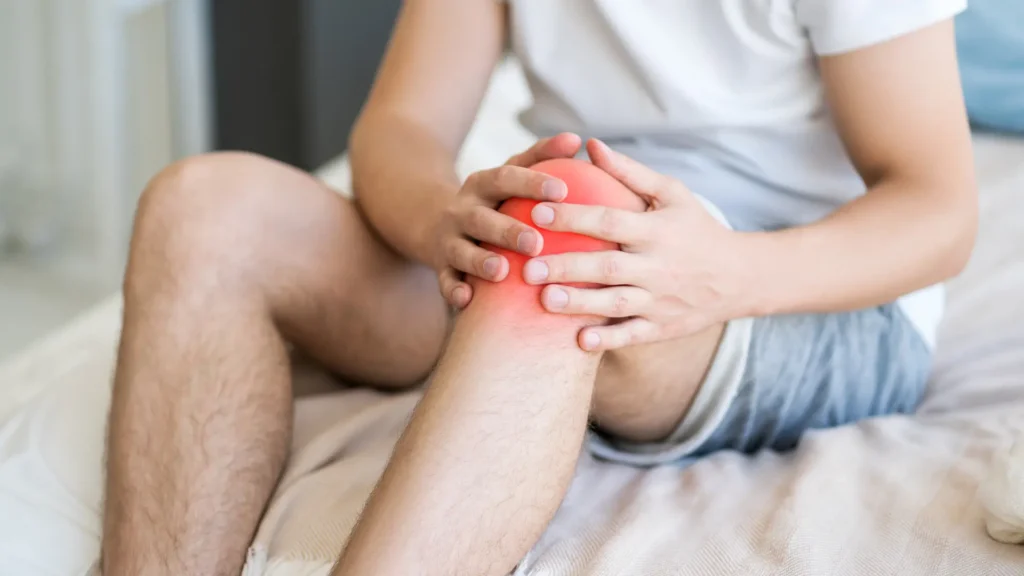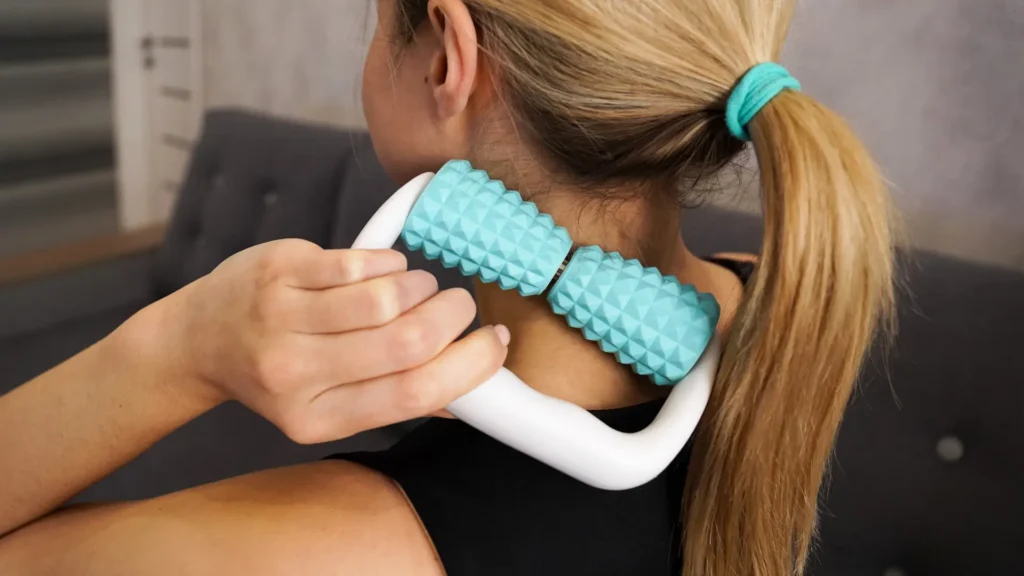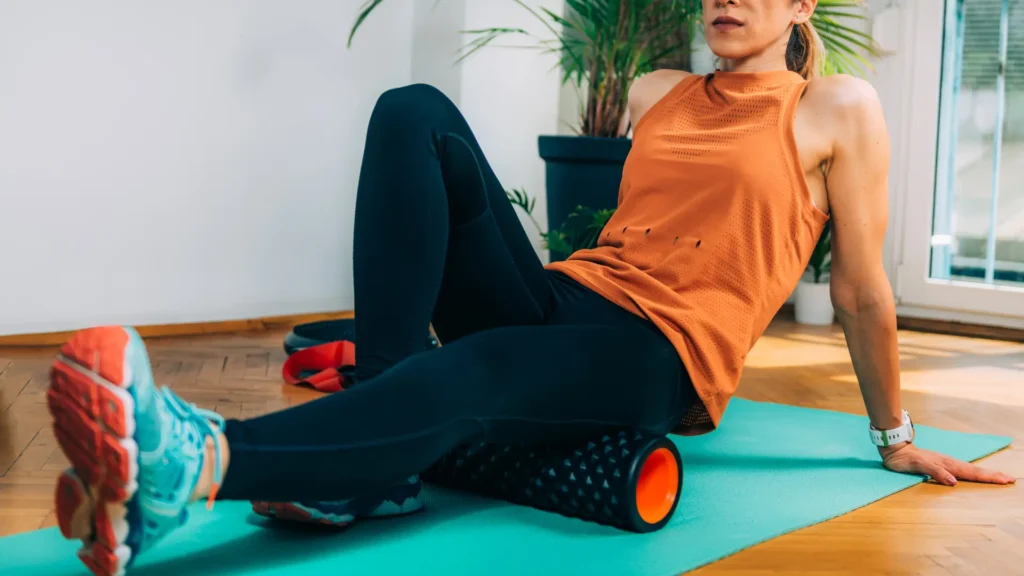In this definitive guide on “How to Perform Deep Tissue Massage at Home,” you’ll explore:
1- The unparalleled convenience and savings of mastering the art of home massage.
2- Expert tips to set the stage for a spa-like experience right in your living room.
3- Essential safety guidelines to ensure every session is both blissful and beneficial.
4- Techniques and tools that’ll transform your self-massage from ‘meh’ to ‘marvelous.’
Ever wondered if you could replicate that deep tissue magic from the spa in the comfort of your own home? Well, wonder no more. Whether you’re looking to alleviate stress after a hectic day or target that stubborn knot in your shoulder, this guide has got you covered.
Ready to embark on this hands-on journey and unlock the secrets of self-massage?
Let’s dive in!
Jump to:
Preparing Yourself for Home Deep Tissue Massage Session
Are you Ready for a deep tissue massage at home? Well, setting the scene is half the battle! Just as a chef preps their ingredients or an artist arranges their palette, you, too, need to get everything in order for that perfect home massage session.
Here’s how:
1. Find Your Zen Zone: Choose a quiet spot in your home, free from distractions. This could be your bedroom, a secluded corner, or even a dedicated massage space if you’re feeling fancy. The key is to select an area where you feel relaxed and at ease.
2. Gather Your Supplies: Before you dive in, ensure you have everything you need. This might include a soft towel, a firm cushion, and, of course, a high-quality massage oil or lotion. Going for that extra touch? Consider a heated blanket for added warmth and relaxation.
3. Set the Mood: Lighting plays a pivotal role in creating a spa-like ambiance. Dim the lights or, better yet, light a few scented candles. Lavender or chamomile scents can be particularly calming. And let’s not forget the tunes! Soft, instrumental music or nature sounds can whisk you away from daily stresses, making your massage experience all the more immersive.
4. Dress for Success: Opt for loose, comfortable clothing. Think soft cotton pajamas or a lightweight robe. If you’re targeting a specific area like your back or legs, ensure it’s easily accessible.
5. Temperature Check: A chilly room can be a relaxation killer. Adjust the room temperature to a comfortable level. Remember, as you massage, you’ll generate heat, so a slightly cooler setting might be ideal.
6. Cleanse & Hydrate: Before you start, take a moment to cleanse the area you’ll be massaging, ensuring it’s free from any lotions or oils. And don’t forget to hydrate! A glass of water pre-massage can set the tone for relaxation.
Now, with your stage set and everything in place, you’re all set for a transformative self-massage journey. Remember, the goal is to replicate that spa experience – so think luxury, tranquility, and utter relaxation.
NOTE: If you’re a Total beginner to this Spa and Don’t know What it is, you must read my following Guide: What is Meant by Deep Tissue Massage? Benefits and Process Explained

Safety Precautions of Deep Tissue Massage At Home
While it’s a splendid way to dive into relaxation and muscle relief, a touch of caution can make all the difference. After all, we don’t want that relaxation dream to turn into a nightmare of strains or discomfort, do we?
Let’s chart out the safety map for your self-massage journey:
1. Know Your Limits: While professional therapists have trained hands that can navigate the intricacies of your muscles when you’re on your own, it’s crucial to know your boundaries. Always start with gentle pressure and gradually increase based on your comfort.
2. Pain isn’t Gain: Unlike that intense workout mantra, when it comes to massage, pain isn’t a sign of progress. If something feels painful or too intense, ease up! Listen to your body’s cues.
3. Avoid Sensitive Areas: Steer clear from areas with wounds, recent scars, rashes, or inflammation. These zones can be sensitive, and applying pressure might exacerbate the issue.
4. Respect Your Pain Threshold: Everyone has a different pain tolerance. What might be a gentle rub for one person could be painful for another. So, always be attuned to your body’s responses.
5. Avoid Over-Massaging: It might feel heavenly, but spending too much time on one spot can lead to bruising or increased sensitivity. Aim for a balanced approach, addressing all areas of tension without dwelling overly long on one spot.
6. Stay Informed: If you have underlying health conditions or injuries or are pregnant, consult with a healthcare provider or professional massage therapist before embarking on your self-massage journey. They can offer insights tailored to your specific situation.
With these safety guidelines in your arsenal, you’re well-equipped to venture into the world of self-massage, ensuring each session is both delightful and harm-free. So, wear that safety hat alongside your relaxation robe and dive into a world of well-informed relaxation!

Choose the Right Techniques for Home Spa from the Following
The art of deep tissue massage is vast and varied, with a plethora of techniques at your fingertips—quite literally! While some techniques are best left to the pros, many can be adapted for an effective self-massage session at home.
Let’s delve into some of these techniques that you can safely incorporate into your routine:
1. Slow, Deep Strokes: Using the palms of your hands, apply steady pressure, moving slowly along the length of your muscle. This technique helps warm up the muscles, priming them for deeper work. Imagine you’re ironing out the creases in a shirt, smoothing and elongating.
2. Deep Pressure: Once you’ve warmed up a particular area, apply more focused pressure using your thumbs or knuckles. Move in circular motions, spending a few seconds on tense spots. Remember, it’s about depth, not force.
3. Friction: For those pesky knots or adhesions, use your fingertips to apply pressure in a back-and-forth motion. This technique helps to break down tight spots and restore flexibility.
4. Compressions: Place your hand or forearm on the target area and apply downward pressure. Hold for a few seconds, and then release. This technique is particularly effective for larger muscle groups like the thighs or back.
5. Stretching: Incorporating gentle stretches can help improve flexibility and enhance the benefits of your self-massage. For instance, after massaging your calf, you might want to gently pull your foot towards you for a light stretch.
6. Tapping: Using the edges of your hands, lightly tap on the muscle area. This percussion-like motion can invigorate muscles and boost circulation.
When enjoying these techniques, always remember the golden rule: listen to your body. If a particular technique feels good, go with it. If it feels uncomfortable or painful, ease up or switch to another method.
NOTE: Here’s a Detailed Guide to Appliance and Benefits to These Techniques: Techniques and Methods Used for a Deep Tissue Massage

Self-Massage Tools and Accessories
Although our hands are pretty fabulous tools in their own right, sometimes they could use a little backup to elevate our self-massage game. Use the self-massage tools and accessories. These trusty sidekicks can help target those hard-to-reach spots and intensify your massage experience.
Let’s explore some of the MVPs (Most Valuable Products) in this realm:
1. Foam Rollers: These cylindrical wonders are a godsend, especially for those tight back and leg muscles. Rolling your body over these can help release tension and improve flexibility. Plus, they come in various sizes and textures to suit your needs.
2. Massage Balls: Think of these as an extension of your fingertips, but with the added ability to dig deeper into those knots. Place the ball on a tense spot, apply pressure, and let the magic happen. They’re particularly great for feet and shoulder blades.
3. Handheld Massagers: These electronic devices offer a range of settings, from gentle vibrations to deep, pulsating motions. They can target specific areas, ensuring you get a thorough massage without tiring out your hands.

4. Massage Sticks: These are like rolling pins for your muscles! They’re fantastic for calves and thighs, allowing you to apply consistent pressure across a broader area.
5. Massage Brushes: These tools, with their firm bristles, can stimulate blood flow and offer a light exfoliation. It’s a two-in-one deal: refreshed skin and relaxed muscles!
6. Warmth Accessories: Consider heated pads or wraps to soothe muscles before or after your massage. The warmth can further relax muscles, making your self-massage even more effective.
Tips for Using These Tools:
- Start Gentle: When trying a new tool, start with gentle pressure to gauge your comfort level.
- Follow Instructions: Many tools come with user manuals or instructional videos. Take a few minutes to familiarize yourself to get the most out of the tool.
- Clean and Store: Ensure you clean your tools after each session and store them in a dry place to maintain their longevity.
Investing in a few of these tools can truly revolutionize your home massage sessions. While our hands are versatile, these accessories can offer specialized relief and help you get deeper into those muscles, all from the comfort of your home. So, next time you’re gearing up for a self-massage, consider inviting one of these handy tools to join the party!
Which Body Areas to Target Specifically?
While a full-body self-massage can be pure bliss, sometimes it’s those nagging, specific areas that cry out for some TLC. Whether it’s the weight of the world on your shoulders or the miles you’ve clocked on your feet, let’s address how to target these common problem areas:
1. Neck: Many of us hold tension in our neck, thanks to hours hunched over screens. For this sensitive area, use your fingertips to apply gentle circular motions from the base of your skull down to your shoulders. Remember, the neck is delicate, so be gentle and avoid any harsh pressure.
2. Shoulders: Ah, the classic tension hotspot! Use your hand or a massage ball and make circular motions around the shoulder blades. Feel a knot? Apply gentle pressure and hold for a few seconds.
3. Back: While the back can be a tricky area to reach, a foam roller or a long-handled massage tool can be your best friend here. Roll or glide the tool up and down your back, paying special attention to the spots that feel particularly tense.
4. Arms & Hands: With your opposite hand, use your thumb to apply pressure along your forearm, working from the wrist up to the elbow. For the hands, gently pull on each finger and use your thumb to massage the palm.
5. Legs & Feet: Legs, especially the calves, can tighten up from standing or walking all day. Use a massage stick or your hands to work from the ankles up to the thighs. As for those tired feet? A massage ball or even a simple tennis ball can do wonders. Roll your foot over the ball, applying pressure where needed.
6. Hips & Glutes: Sitting for extended periods can lead to tight hips. Use a foam roller or your hands to apply pressure, making sure to cover the entire hip area. For the glutes, sit on a foam roller or massage ball and roll around to hit all the tight spots.
General Tips:
- Warm Up the Area: Before diving deep, spend a few minutes warming up the area with some gentle strokes. This prepares the muscles and increases circulation.
- Pace Yourself: Don’t rush. Spend time on each area, and if you find a particularly tense spot, take a moment to focus on it.
- End with a Stretch: After massaging a specific area, it’s always beneficial to follow up with a gentle stretch to enhance flexibility.
Focusing on these specific areas can make a world of difference, offering targeted relief where you need it most. So, the next time your shoulders feel like they’re housing a family of knots or your feet are screaming out in protest, know that with the right techniques, relief is just a self-massage away!

Proper Body Mechanics
So, you’re all set with techniques, tools, and targeted areas. But here’s the cherry on top: ensuring you’re massaging in a way that won’t inadvertently cause strain or injury to yourself. Proper body mechanics is the unsung hero of self-massage.
Let’s ensure you’re equipped with the right posture and positioning knowledge:
1. Stable Stance: Whether you’re standing or sitting, ensure your stance is stable. Distribute your weight evenly, and if you’re on your feet, keep them shoulder-width apart for optimal balance.
2. Engage Your Core: When applying pressure, especially to harder-to-reach areas, engage your core muscles. This provides stability and helps prevent any unnecessary twisting or straining.
3. Move from Your Hips and Shoulders: Instead of using just your hands or arms to generate pressure, try to use your whole body. Move from the hips and shoulders, allowing the larger muscle groups to do the bulk of the work.
4. Keep Your Joints Aligned: When massaging, ensure that your wrists and fingers are in a straight line. Avoid bending or twisting your wrists excessively.
5. Avoid Overreaching: If you’re trying to get to that elusive spot on your back or shoulders, don’t overstretch or twist your body awkwardly. This is where tools like long-handled massagers or foam rollers can come in handy.
6. Mind Your Spine: Maintain a neutral spine. Whether you’re sitting or standing, avoid slouching or arching your back excessively. Using a mirror can help you check and maintain a good posture.
7. Take Breaks: If you’re diving into a longer self-massage session, it’s okay (and recommended) to take short breaks. Shake out your hands, stretch a bit, and then continue.
8. Listen to Your Body: This cannot be emphasized enough! If a certain position feels awkward or causes strain, adjust. Your body will often give you subtle cues; heed them.
By focusing on proper body mechanics, not only do you enhance the effectiveness of your self-massage, but you also ensure you’re taking care of your body in the process.
Think of it as a dual benefit: as you work to relieve tension in one area, you’re simultaneously preventing it in another. It’s all about striking a harmonious balance, ensuring each self-massage session leaves you feeling rejuvenated, not just in the targeted area but holistically.

Breathing and Relaxation
Breathing: it’s so fundamental to life that we often take it for granted. Yet, when paired with self-massage, it transforms from a mere physiological necessity to a powerful tool of relaxation and comfort.
Let’s explore how to harness the magic of breath during your self-massage sessions:
1. The Power of Breath: Proper breathing not only oxygenates your body but also helps release tension. As you breathe deeply, your muscles get the signal to relax, making your massage efforts doubly effective.
2. Start with a Breathing Ritual: Before delving into the massage, take a few moments to ground yourself. Close your eyes, take a deep breath through your nose, hold for a second, and then exhale slowly through your mouth. Repeat this 4-5 times to set a calm tone for the session.
3. Breathe Through the Tension: When you encounter a particularly tense or sore spot, your natural instinct might be to hold your breath. Instead, focus on breathing into that area. Imagine the oxygen reaching and soothing the tense muscles as you exhale.
4. Rhythmic Breathing: Try to establish a rhythm. For instance, breathe in as you apply pressure and breathe out as you release. This rhythm not only keeps you focused but also ensures that your body remains relaxed throughout.
5. Exhale on the Intense Bits: When working on a knot or applying deeper pressure, make a conscious effort to exhale. This helps in managing any discomfort and encourages the muscle to release.
6. End with a Breathing Cool-Down: Just as you began with deep breathing, wind down your session the same way. This helps to further relax your body and marks a clear end to your self-massage time, allowing you to transition back to other activities smoothly.
Benefits of Breathing in Self-Massage:
- Enhanced Relaxation: Coupled with breathing, your self-massage session can be an oasis of relaxation.
- Better Pain Management: Proper breathing can act as a natural pain reliever, especially when dealing with sore spots.
- Increased Awareness: Being in tune with your breath helps you be more present during the massage, ensuring you address each area effectively.
The age-old adage, “Just breathe,” holds a treasure of wisdom. In the context of self-massage, your breath becomes an ally, guiding you, enhancing the massage’s effectiveness, and turning the session into a holistic experience.
So the next time you set out for a self-massage, remember to breathe in the relaxation and breathe out the tension.
Duration and Frequency for Self-Deep Tissue Massage
Diving into the world of self-massage is exhilarating, but one might wonder, “How long should each session last?” and “How often should I indulge in this self-care ritual?”
Here’s a breakdown to help guide your self-massage journey:
Session Duration:
1. Quick Sessions (10-15 minutes): On a hectic day, even a short 10-minute session can work wonders. Focus on tension hotspots or areas that feel particularly stiff. Think of it as a mini reboot for your muscles!
2. Standard Sessions (20-30 minutes): This duration is ideal for a more comprehensive massage. It provides ample time to address several areas of the body or to give detailed attention to one particular zone.
3. Extended Sessions (45-60 minutes): For those indulgent days when you really want to dive deep, an extended session can feel heavenly. It allows for a full-body exploration, ensuring no muscle is left unattended.
Frequency – How Often to Dive In Self Deep Tissue Massage:
1. Daily Quick Massages: Short, daily sessions can be excellent for maintaining muscle health, especially if you have a demanding physical routine or job.
2. 3-4 Times a Week: For a balanced routine, consider massaging specific areas of concern multiple times a week. This keeps the muscles limber and addresses any budding tension before it escalates.
3. Weekly Deep Dive: Consider a longer, more indulgent session once a week. This acts as a reset button, ensuring you head into the next week feeling refreshed and rejuvenated.
Tips for Effective Self-Deep Tissue Massage Sessions:
- Consistency is Key: Even if you’re opting for shorter sessions, maintaining regularity can optimize the benefits.
- Tune into Your Needs: Some weeks, your shoulders might demand more attention, while on others, it could be your calves crying out. Stay attuned to your body’s signals and adjust your focus accordingly.
- Listen to Your Body: If you ever feel sore or overly sensitive, post a massage and give that area a break for a day or two before revisiting.
Ultimately, the ideal duration and frequency of self-massage boil down to individual needs and preferences. It’s your personal journey, and these guidelines are mere signposts. So, as you continue to explore the art of self-massage, let your intuition guide you, and let each session be a testament to self-love and care.
Post-Massage Self-Care
Alright, you’ve just wrapped up a blissful self-massage session. Your muscles are singing praises, and that nagging knot in your shoulder? Gone!
But the journey doesn’t end here. The aftercare is just as essential as the massage itself.
Here’s how to ensure you maximize the benefits of your self-massage:
1. Stay Hydrated: During your massage, toxins, and metabolic wastes get released from the muscles. Drinking water helps flush these out of your system. Imagine it as giving your insides a mini spa session, too!
2. Stretch It Out Gentle stretches can further enhance the benefits of your massage. Think of it as a lovely bonus for your muscles – they’ve been worked on, and now they get a gentle stretch to boost flexibility and relaxation.
3. Warmth is Wonderful: Consider a warm shower or bath after your massage. The warmth can soothe muscles further and offers a cozy continuation to your self-care session.
4. Nourish Your Skin: Apply a moisturizing lotion or oil to keep your skin hydrated, especially if you’ve used massage oils. This adds an extra layer of pampering.
5. Rest and Reflect: If possible, take a few moments to relax post-massage. Whether it’s lying down, meditating, or just sitting in a cozy nook with a cup of tea, allowing your body to absorb the benefits of stillness can be powerful.
6. Limit Strenuous Activity: Post-massage, your muscles are relaxed and might be a tad tender. It’s wise to avoid intense physical activities for a few hours. Let those muscles bask in the post-massage glow!
7. Feedback Loop: Take a moment to reflect on your self-massage session. Were there areas that felt particularly good? Any spots that were too sensitive? This feedback helps refine your technique for future sessions.
8. Avoid Alcohol and Caffeine: These can be dehydrating and might reduce the beneficial effects of your massage. Instead, opt for herbal teas or fruit-infused water.
Remember, a self-massage session is not just about the act itself but the entire experience. The before, during, and after – it’s a holistic journey. By giving due attention to post-massage care, you’re not only extending the benefits but also showing your body the love and care it truly deserves. Here’s to many more self-massage sessions wrapped in layers of self-love and mindful aftercare!
Why and When Seek Professional Guidance About Self-Deep Tissue Massage?
While the joys and benefits of self-massage are numerous, there are moments when the expertise of a trained professional is invaluable. Even if you’ve mastered the art of home massages, seeking advice or sessions from certified therapists can further enhance your well-being.
Here’s why and when you might want to consider it:
1. Complex Concerns: If you’re dealing with chronic pain, injuries, or specific health conditions, a professional can provide tailored treatments that cater specifically to your needs.
2. Technique Enhancement: Even if you’re a seasoned self-massager, a session with a professional can offer insights into techniques you might not know or correct nuances in your current methods.
3. Hard-to-Reach Areas: Let’s admit it; there are spots we just can’t seem to get to, no matter how we twist and turn. A therapist can ensure these neglected areas receive the attention they deserve.
4. Deep Dive Analysis: Professionals can often pinpoint underlying causes of muscle tension or pain that might be missed during self-massage. They can provide advice on posture, lifestyle habits, or exercises that can aid in overall muscle health.
5. Safety First: If you have underlying health concerns or are pregnant, it’s imperative to consult a professional before diving into self-massage. They can provide guidance on what’s safe and what to avoid.
6. Holistic Approach: Many therapists don’t just stop at massage. They might provide guidance on stretching, nutrition, and other holistic approaches to complement the massage benefits.
Tips for Seeking Professional Guidance:
- Credentials Matter: Ensure the therapist is certified and comes with good recommendations.
- Open Communication: Be upfront about your needs, concerns, and any pain points. This will help them tailor the session to your requirements.
- Combine & Enhance: Use professional sessions as an addition to your home self-massage routine. The combination can offer a comprehensive approach to muscle health and relaxation.
Self-massage is a vibrant thread, but professional guidance adds intricate patterns, making it richer and more beneficial. There’s no harm in seeking an expert touch now and then. After all, when it comes to your well-being, every knot, stretch, and stroke counts!
Final Thoughts On How to Perform Deep Tissue Massage at Home
Congratulations! You’re a self-deep massage expert Now. I’ve tried to expose all the secrets to relaxation, muscle relief, and overall well-being so you can enjoy it right from the comfort of your home.
Let’s recap the essential takeaways:
- Create a Relaxing Space: Set the stage for your massage with a tranquil environment, soothing music, and dim lighting.
- Prioritize Safety: Learn and follow safety precautions to ensure your self-massage remains a blissful experience, free from injury.
- Choose the Right Techniques: From slow, deep strokes to targeted pressure, tailor your techniques to your needs for effective self-massage.
- Enhance with Tools: Explore self-massage tools and accessories to level up your experience and reach those stubborn spots.
- Target Specific Areas: Address common problem areas in your neck, shoulders, back, legs, and feet, and witness the tension melt away.
- Mind Your Mechanics: Proper body mechanics not only enhance your massage but also protect you from strain or discomfort.
- Breathe and Relax: Harness the power of controlled breathing to deepen relaxation during your self-massage sessions.
- Time it Right: Customize your massage duration and frequency to suit your schedule and needs.
- Embrace Post-Massage Care: Hydrate, stretch, and nourish your body to maximize the benefits and prolong that post-massage glow.
- Seek Professional Guidance When Needed: Don’t hesitate to consult a certified therapist for complex concerns or to enhance your self-massage skills.
As you continue your self-massage journey, remember that each session is a unique opportunity to connect with your body, release tension, and nurture your well-being. Whether you’re unwinding after a long day or addressing specific discomfort, the art of self-massage is a gift you can give yourself time and time again. So, go ahead, schedule your next self-massage session, and let the relaxation flow.
Don’t hesitate to ask if you have any questions in the comments. I would love to help you out!











